
Studio monitors are a crucial component when building a home recording studio, but when you are on a budget, every dollar counts. That’s why here at virtuoso central, we have prepared a list of the best studio monitors on a budget that will be the perfect addition to your studio to save you the time and hard work of choosing from the endless options available.
Finding the best budget studio monitors shouldn’t be a difficult task, but choosing the wrong one will cost you money and will ultimately affect the quality of your recordings negatively. The reason is that when mixing or editing, you will adjust the audio depending on what you hear coming out of the monitors. If the response of the monitors isn’t accurate, the final recording will be affected. Just remember that your mix is as good as your studio monitors(1).
In this post, we present the 10 best studio monitors on a budget, dissecting in detail all of the features they have to offer. These reviews can help your decision making to be easier when buying studio monitor speakers.
Best Studio Monitors On A Budget
The 10 best studio monitors on a budget are:
- PreSonus Eris E3.5
- Alesis Elevate 5 MKII
- Mackie CR4
- Behringer STUDIO 50USB Powered Studio Monitors
- Pioneer DM40 Studio Monitor
- JBL 305P Professional Studio Monitors
- Kali Audio LP-6 Studio Monitor
- KRK Classic 5 Studio Monitors
- ADAM Audio T5V
- Yamaha Hs5 Powered Studio Monitor
Let’s explore each one in detail to find out what makes them so special.
PreSonus Eris E3.5
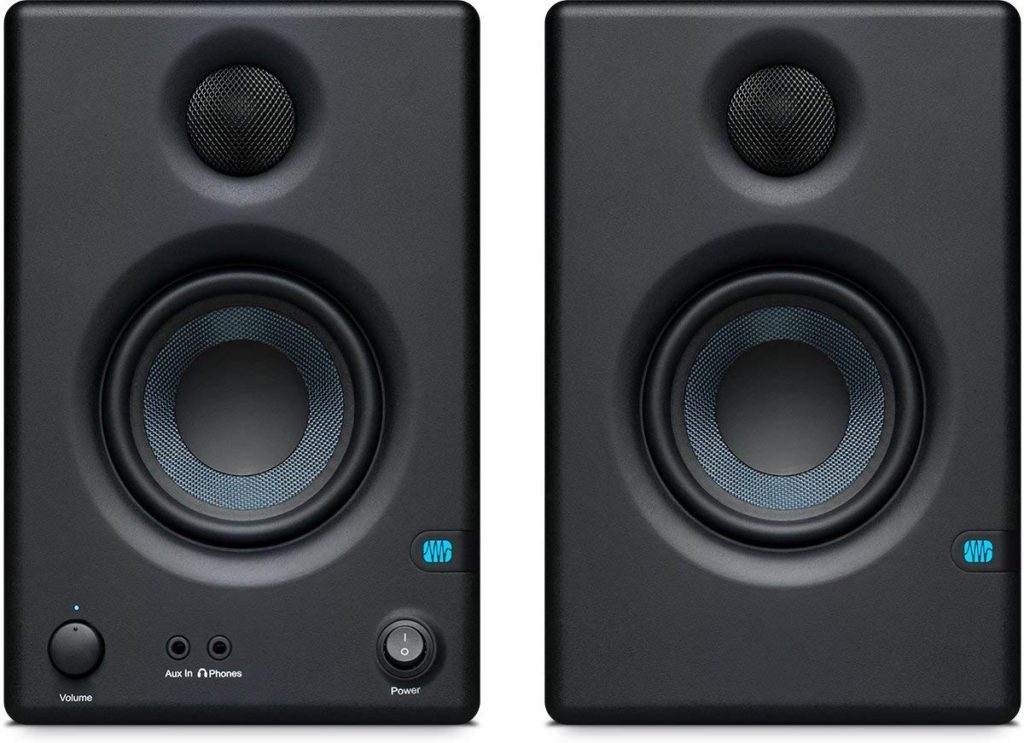
The Presonus Eris series is one of the best studio monitors on a budget because the sound they deliver is worth way more than its price tag. The Eris E3.5 powered monitor has a clear, accurate sound that is essential in recording studios, plus it comes with all the necessary inputs and controls found in high-end studio speakers.
The Eris E3.5 comes with a 3.5” woven composite woofers that produce a powerful, accurate bass and mid-range frequencies. The crossover frequency is 2.8kHz, meaning that the 3.5″ low-frequency driver is responsible for reproducing sound from 80Hz – 2.8kHz.
It comes with a 1” silk-dome tweeter designed to radiate sound with a wide dispersion pattern, producing a smooth, clear, bright tone, and delivering accurate transients between 2.9kHz – 20kHz. So, the total frequency response of the Eris E3.5 is between 80Hz-20kHz.
Each speaker is powered by a 25W amplifier, for a total of 50W with both speakers. The maximum sound pressure level at 1 meter is 100dB, which is very loud in a studio scenario because it is an enclosed area. This is the perceived volume at maximum power.
When it comes to connectivity, you can connect the Eris E3.5 to any line-level sound source. It has one Stereo 1/8″, two Balanced ¼” TRS (tip, ring, sleeve), and two Unbalanced RCA connectors.
The cabinet is built with medium-density fiberboard and vinyl-laminated. The size of each speaker is 5.6″ x 6.4″ x 8.3″ or 141mm x 162mm x 210mm. The pair of speakers weigh 6.4lb / 2.9kg.
Features
- It comes with several protection circuitries: RF interference, Output-current limiting, Over-temperature, Turn-on/off transient, Subsonic filter, external mains fuse.
- At this price range, these are the only monitors that come with acoustic tuning for mid and high frequencies so that you get a consistent sound.
- It delivers studio-quality sound with smooth and accurate frequency response.
- Rear-firing acoustic port for better low-frequency reproduction.
- Front panel A-type taper volume control knob.
- For superior resonance suppression, it comes with optimized internal bracing.
- It features an integrated stereo headphone amplifier with front-panel 1/8-inch output.
Pros
- Good quality
- Excellent studio sound
- Unbeatable price for a pair of good quality near field studio monitors.
Cons
- If you have sensitive ears, while there is no music playing on the speaker, you could hear the tweeter hiss. Some people find it annoying.
- Depending on the size of your studio, it might not be powerful enough to fill the room with a lot of volume. Just remember, these are near field studio monitors don’t expect them to work as a regular loudspeaker.
Alesis Elevate 5 MKII
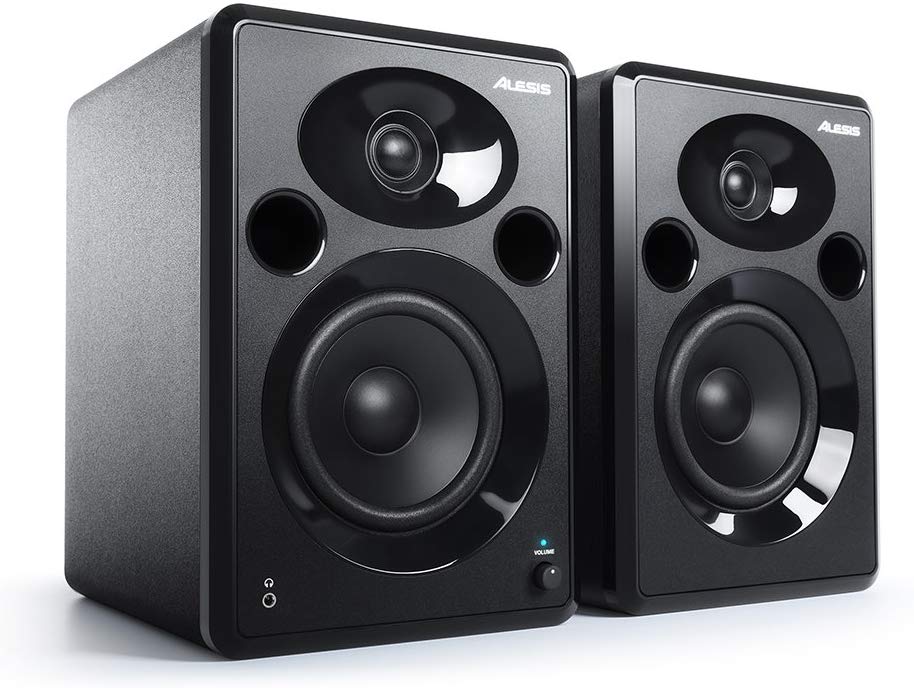
When you are in your studio listening to your mixes, editing, mastering, or working on any multimedia project, you need speaker monitors that can produce a clear uncolored sound so that your mixes end up sounding the way you intended.
The Alesis Elevate 5 was designed by Alesis engineers to create a studio monitor that delivers full lows, clean and clear highs with every detail. Let’s see what makes it one of the best studio monitors on a budget.
The Sound Quality Alesis Elevate 5
Each cabinet uses one 5″ low-frequency woofers and a 1” silk dome tweeters for high frequencies. A 40W amplifier per channel powers it, the total power is 80W.
A remarkable characteristic of the Elevate 5 is how flat and natural it sounds. The speakers have a frequency response between 56Hz-20kHz. What this means is that when you are mastering, editing, or just listening to your tracks, the sound coming out of the monitors will be as close as possible to the original signal—therefore enabling you to make the necessary adjustments.
If a studio monitor is poorly designed, the sound it provides could have too much bass or too much treble, and the adjustments you make in the EQ would be wrong. As a consequence, your track will sound annoyingly bright or too muddy.
Build Quality
Alesis builds this studio monitor using high-density woods, helping suppress unwanted resonance. If the wood used to construct the enclosures is not a high-density material, when the speaker vibrates and the sound waves hit the cabinet, the wood vibrates and creates resonant frequencies that are not present in the original signal. For such reason is always recommended to buy monitors speaker like the Alesis Elevate 5 that uses high-density woods for its construction.
I/O Capabilities
With the Elevate 5 you get flexible connectivity. It comes with a pair of good quality RCA jacks, two 1/4″ TRS jacks connectors, which are excellent for connecting your mixer, audio interface, computer, or any other audio gear with a line-level signal.
It also comes with a 1/8″ stereo headphone connection to enable you to use the system at any time not to bother others while working late at night.
Features
- The Elevate 5 comes in matched stereo pair sets to deliver the most accurate sound possible.
- The cabinet is magnetically shielded in case you want to place it close to video monitors in the studio.
- Highs and lows and separated with a frequency crossover circuit.
- With this studio monitors, you get a flat response, but if you need extra punch on the bass, it has a bass-boost switch to increase the bass response.
- The elliptical tweeter waveguide optimizes dispersion and stereo imaging.
Contents of the Box
In the box, you’ll find all you need to have the speaker ready to receive the signal from your interface or mixer.
2 x Elevate 5 MKII Speakers (Stereo Pair)
1 x RCA-to-1/8” (3.5mm) Audio Cable
1 x 1/4” (6.35mm) Interconnection Cable
1 x Power Cable
1 x Quickstart Guide
1 x Safety & Warranty Manual
Mackie CR4 Studio Monitors
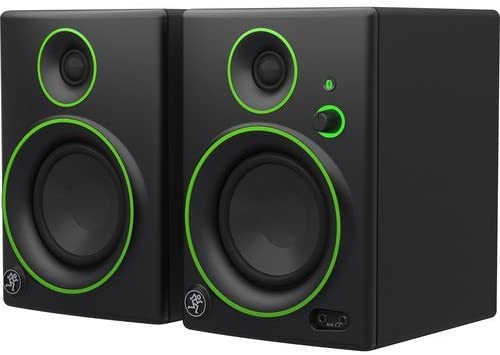
Another excellent option that made the list of the best studio monitors on a budget is the Mackie CR4. This pair of affordable studio monitors are designed to perform well and provide you with studio-quality sound ideal for your home studio, multimedia creation, and entertainment.
The Sound Quality of the Mackie CR4
Mackie is well known for making excellent sound gear, and the CR4 continues with this legacy. It uses a 4″ polypropylene-coated woofer that provides an incredible low-frequency response. For the highs, it uses a 3/4″ ferrofluid-cooled silk dome tweeter providing accurate, crisp highs enabling you to master and edit your recordings with precision.
The CR4 is powered by a 28W RMS class AB stereo amplifier with a peak power of 50W. But this means nothing. All we need to know is the loudness these monitors can deliver, and it is 100dB at 1 meter. That is more than enough for a small home studio recording.
It provides a full frequency response that goes from 60Hz to 20kHz, perfect for any audio editing or just for listening to tracks.
The waveguide design in the Mackie CR4 delivers a clean and clear, articulate stereo sound that is consistent at any volume.
Thanks to its wooden enclosure construction, these studio monitors can deliver a natural sound that is flat perfect for studio recordings.
Build quality
The Mackie CR series of monitors have a professional build quality. The enclosure is constructed from high-quality solid MDF for delivering better sonic response and high-quality components usually found in more expensive units. It uses a black vinyl wrap for a finish.
I/O Capabilities and Controls
Input connectors:
- 2 x RCA unbalanced connectors in the rear panel.
- 2 x 1/4″ TRS balanced connectors in the rear panel.
- 1 x 1/8” TRS balanced connector in the front.
Output connectors:
- 1 x 1/8” stereo headphones connector in the front.
In the front panel, there is a conveniently located volume knob with a lit ring that serves as the on/off indicator and also for the volume level.
Features
- The CR4 delivers excellent sound and quality that no other studio monitor can provide at this price range.
- It comes with cables and included accessories to start using them right away.
- It comes with handy features like a front panel aux connection to allow you to connect your phone, tablet, or laptop computer quickly.
- It comes with a left\right switch for speaker placement. What this means is that you have the freedom to locate the speaker that has the volume control either at the left or right by selecting the correct switch position.
- Carefully designed rear port for providing an evenly distributed bass response.
Contents of the Box
Inside the box, you will find:
- One pair of CR4 monitor speakers
- 1 x 1/8” stereo to RCA cable for connecting any computer to the speakers.
- 1 x 1/8″ to 1/8″ stereo cable for connecting your phone, laptop, or tablet to the speakers.
- 1 x speaker-to-speaker cable.
- 2 x acoustic isolation pads for reducing unwanted vibrations and boomy bass, plus the pads can be used to provide up/down tilt control if needed to achieve a more focused listening.
Behringer STUDIO 50USB
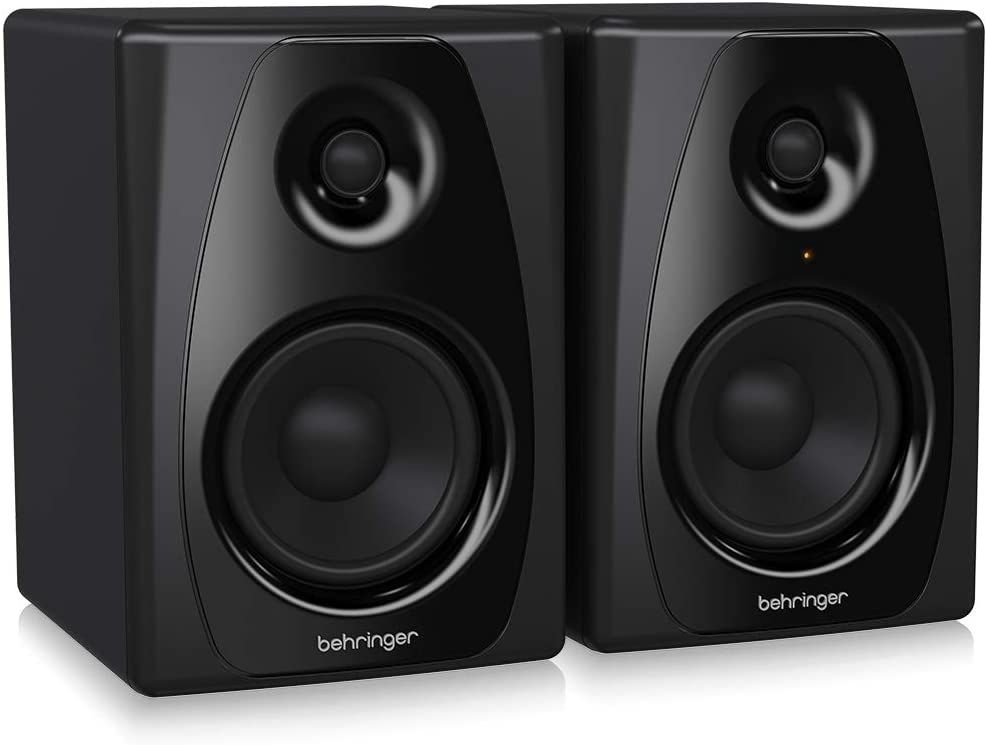
Whether you are a singer, rapper, or musician creating your new hit song in your home recording studio, you need a pair of studio monitors that can provide you with accurate sound. This is why even when you are looking for the best studio monitors and you are on a budget, it’s essential to get something that, although it is affordable it will deliver pristine sound. This is where the Behringer Studio 50USB comes in; let’s explore it in more detail.
The Sound Quality of the Studio 50USB
As one of the best affordable studio monitors available in the market, the sound quality it delivers is excellent. The bass response is punchy and deep, and the tweeter provides crisp, clear high-frequency sound.
Each Studio 50USB speaker is built using one 5” low-frequency, long-throw woofer with deformation-resistant cone for ultimate bass response. For the high-frequency reproduction, these monitors use an ultra-high resolution 1″ silk dome tweeter.
Behringer designed the Studio 50USB using a bi-amplified topology. Basically, they use an active electronic crossover to divide high and low frequencies, then use one amplifier for the woofer and one amp for the tweeter.
The crossover frequency is 2.5kHz. Anything below 2.5kHz will be reproduced by the woofer and everything above 2.5kHz will be reproduced by the silk dome tweeter.
Being that these monitors use a bi-amplified topology, they have a total of four class-D amplifiers, one per component. The maximum power this system can deliver is 150W, and the maximum loudness SPL is 100dB at 1 meter, loud enough for any home studio environment.
The frequency response is between 55Hz and 20kHz, providing you with a wide response for any editing, mastering, or multimedia creation.
Build Quality
The material used to build the enclosure is a plastic composite. Although this is not the best material for building speaker enclosures if the cabinet is thick enough, it will have the necessary density so that the vibrations produced by the woofer don’t create unwanted harmonics.
I/O Capabilities and Controls
As with most studio monitors, it has the necessary connections for connecting your audio interface, mixer, or computer. These are the connections and controls it provides:
- 2 x XLR, balanced Input.
- 2×1/4” TRS, balanced input.
- USB2.0,type B for digital input/output.
- Adjustable input trim knob for ±6dB.
- Switchable high frequency at 12kHz for +2/0/-2/-4 dB
Features
- True bi-amplification using one amp per component.
- USB input for connecting directly to any digital stereo audio source.
- Behringer designed the Studio USB50 with an advanced waveguide technology to provide the ultimate sound dispersion and get consistent quality sound in a large enough area that should cover your recording studio.
Cons
- The enclosure is made from plastic composite.
- No volume control at the front panel.
- No headphones output with this speaker.
Pioneer DM40 Studio Monitors
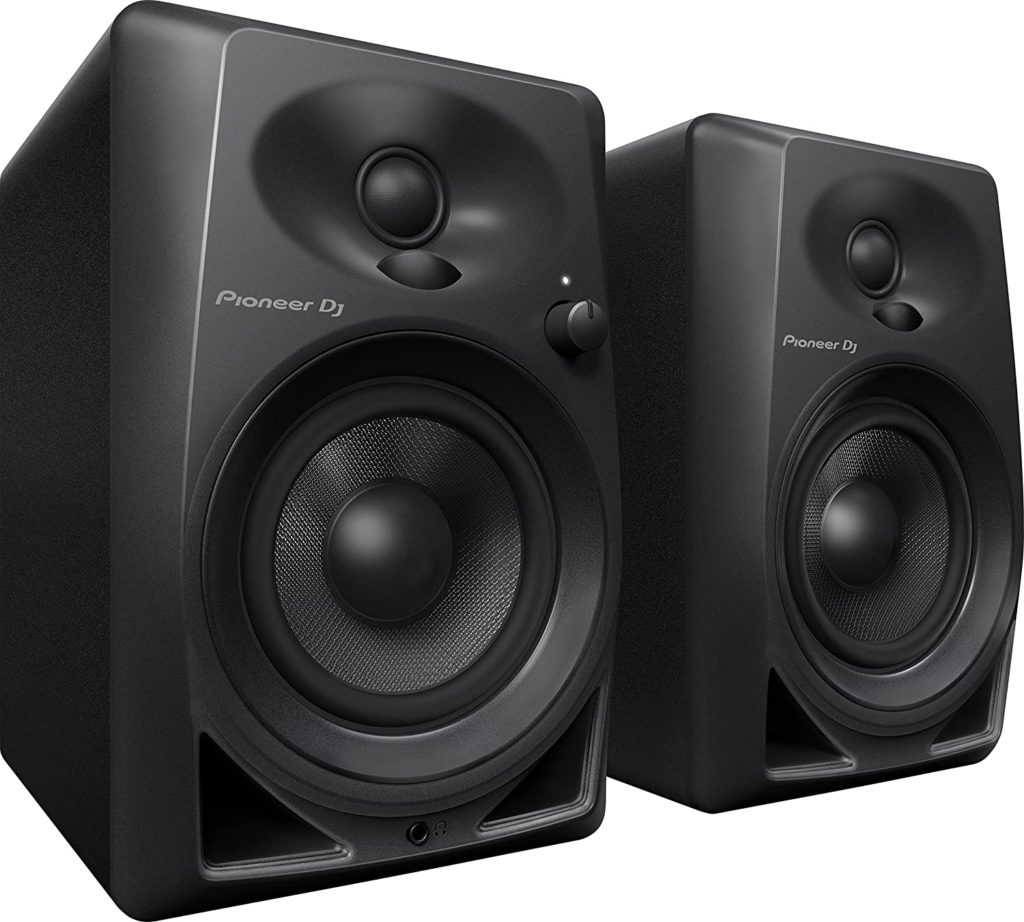
Pioneer consumer electronics brand has been in the market since 1938, making some of the best electronic equipment. The DM40 studio monitor is not the exception because they deliver outstanding sound quality. These monitors inherit the best from the S-DJX series and Pioneer’s Pro Audio speakers. Let’s explore them in more detail.
The Sound Quality of the Pioneer DM40
The excellent sound of the DM40 is why these monitors are considered one of the best studio monitors on a budget. They sound great and are affordable, what better than that.
Thanks to its 4″ fiberglass cone woofer, the bass is tight and punchy. For the highs, the 3/4″soft dome tweeter reproduces crisp, detailed high-frequencies in every direction. The frequency response goes from 70Hz to 30kHz. With this wide response, editing, mastering, or multimedia creation can be done with accuracy.
The design of the enclosure plays an essential role in the sound these monitors produce. For example, it has grooved ducts to reduce air friction, and the front-loaded bass reflect system delivers clear, punchy bass towards the front, even if the speakers are against the wall or any other surface.
The tweeter and woofer are perfectly aligned to ensure a well-balanced response at a wide range of frequencies.
Everything is powered by a 2 x 21 W at 4 Ohms, stereo class-AB amplifier that offers very low distortion, a must in studio monitors.
Note: These speaker monitors are designed to be used as studio monitors, some customers complained that they don’t deliver enough bass for listening to tracks, but the DM40 is not intended for that kind of use. Instead, they are designed to have a rather flat response so that when mixing or editing, you can make the right adjustment in the EQ so that the recording sounds the way you intended.
I/O Capabilities and Controls
Inputs
- 1 Line (RCA)
- 1 Line (Mini-jack)
Outputs
- 1 Headphone Monitor (Mini-jack)
Controls
- Volume Knob in the front panel of the speaker
Pros
- Exceptional design that delivers excellent sound.
- The Pioneer DM40 delivers crisp and clear highs, balanced mids, and punchy lows.
- Great price
Cons
- No balanced 1/4″ TRS connector, being that this is the most common connector in the studio setup.
- It doesn’t have frequency control adjustment to compensate in case is needed.
Contents of the box
These studio monitors come with everything you need to connect them and start using them right away. In the box you’ll get:
- 2 x DM-40 speakers.
- 1 x Power cord.
- 6.5ft (2 m) of speaker cable for left/right channel connection.
- 1 x 3.5 mm stereo mini-plug to RCA cable.
- 8 X Bottom cushion for isolating the speaker from the surface.
- Operating instructions
JBL 305P MkII Studio Monitors
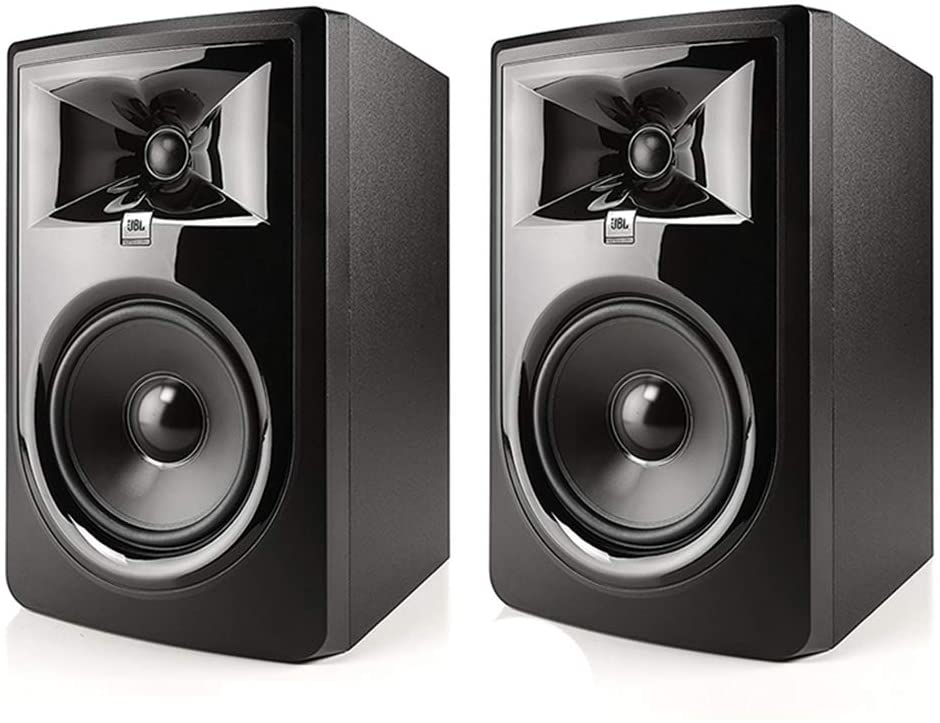
For the past 70 years, JBL has made some of the best professional audio equipment the world has ever seen. During this time, JBL engineers have perfected their products to provide reliable equipment.
As one of the best studio monitors, whether you are on a budget or not, with the 305P MkII professional studio monitors, you get the legendary JBL performance at an affordable price, making it available to every home or professional studio. Let’s see what makes these monitors so unique.
Important: Please note that the JBL 305P MkII monitor is sold by the UNIT and not in pairs. For a studio, you would need two of them.
The Sound Quality of the JBL 305P MkII
With the JBL 305P you get remarkable detail, precise sound, and a wide dynamic range that enhances your critical listening when mixing or editing in the studio.
Thanks to its updated 5” long-throw woofer, you can hear deep, precise, tightly controlled bass with excellent low-frequency linearity, low harmonic distortion, and not a muddy rumble.
For high-frequency reproduction, JBL engineers designed a 1″ woven-composite, neodymium tweeter with a fast transient response thanks to a fine-tuned ferrofluid damping material, that delivers crisp detailed highs.
The sound that comes out of this monitor is a sound you can trust when working in the studio. Its neutral frequency response and accurate dynamics make the JBL 305P unbeatable at this price range.
The frequency response is from 49Hz to 20kHz. The electronic frequency crossover is set at 1725Hz. The 5” LF driver takes care of the frequencies between 49Hz and 1.725kHz, and the 1” tweeter anything between 1.725kHz and 20kHz.
This is a bi-amplified powered monitor, which means that it uses one 41W Class-D amplifier for the woofer and one 41W Class-D amplifier for the tweeter. The maximum SPL this monitor can deliver is 108dB, and for continuous SPL is 94dB.
Build Quality
To achieve good quality sound, the enclosure of a speaker plays an important role. The enclosure of the JBL 305P is made using 15mm MDF wood, which provides the density needed so that when the speaker vibrates at high volumes, no unwanted harmonics are created, providing an accurate tight bass.
The front panel of the speaker is made from injection-molded structural ABS, and the enclosure finish is matte black PVC.
I/O Capabilities and Controls
The monitor comes with the following analog connections and controls:
Inputs
- 1 x XLR female
- 1 x TRS female, balanced
Controls
- Volume control knob in the back panel.
- Adjustable input sensitivity switch +4dBu/-10dBV sensitivity.
- Boundary EQ switches for selecting -3dB, -1.5dB, and 0dB attenuation to decrease the low-end boost that can occur when the monitor is placed directly on the desktop or near walls.
- 3-position HF Trim switch allows you to adjust the high-frequency response between -2dB, 0dB, and +2dB.
Features
- JBL uses its patented Image Control Waveguide to get detailed imaging and a broad, room-friendly sweet spot, no matter where you are in the room.
- Another innovative feature is JBL’s Patented Slip Stream, which is a low-frequency port located in the back of the speaker to get a superior bass performance at all playback levels.
- The design of the monitor is modern and sleek.
- At this price range, you are getting professional-grade monitors.
- Flat response, perfect for making the correct adjustments when recording or mixing.
Dimensions and Weight
Dimensions
Cabinet Dimensions (H x W x D) 298 x 185 x 231 mm (11.75″ x 7.3″ x 9.9″)
Weight
Net Weight: 4.73 kg (10.43 lbs)
Contents of the Box
In the box you’ll get:
- 1 x 305P MKII studio monitor
- 1 x Power Cord
- 1 x quick setup guide
- 4 x peel-off rubber pads
Kali Audio LP-6 Studio Monitor
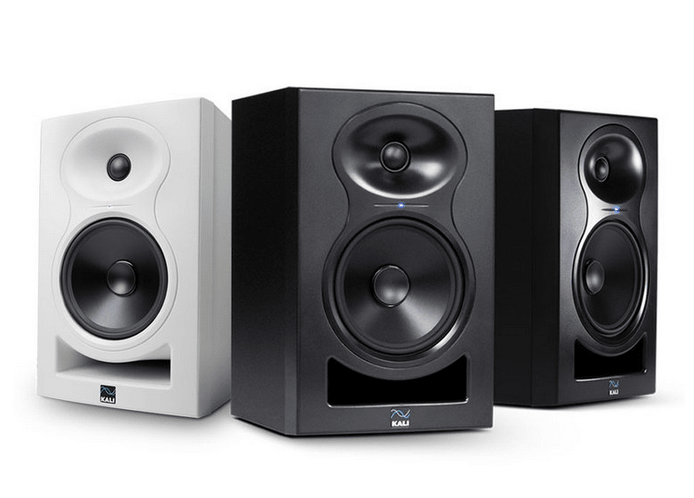
If you want to hear every detail of your mix, you have to get the Kali LP-6. This monitor is going to reproduce whatever is present in your mix thanks to its incredible flat response over the whole frequency spectrum. It doesn’t boost or suppress anything, providing you with real sound so that you can make the necessary adjustments and get the mix you’re looking for. Let’s explore it in more detail.
Note: This monitor is sold individually; for a studio, you need two of them.
The Sound Quality of The Kali LP-6
As mentioned in Kali’s website, the most critical aspect of studio monitors is accuracy because this is what you will hear, and depending on the sound you get, you will adjust accordingly. This speaker was independently tested by Pro Sound Testing just to receive an unbiased result, and the results were just as claimed by the manufacturer.
The excellent accuracy is achieved thanks to the high-quality components used to build the monitor and the precise enclosure design. The sound it produces is razor-sharp highs with crisp details and well balanced flat Mids. The lows are punchy and tight, with no low-frequency harmonics.
Its woofer is 6.5″ with dual-layer voice coil that has a large diameter to allow for low distortion and high dynamic range. The tweeter is a 1” soft dome with a waveguide Kali’s calls “3-D imaging that enables you to hear three dimensional sound from a stereo pair of LP-6.
As with most professional-grade monitors, this one is bi-amplified, meaning that it uses two separate class-D amplifiers for each one of the transducers. The HF driver is powered by a 40W amp, and the LF woofer is powered by another 40W amp for a total 80W RMS. At maximum volume, the SPL is 112dB, and a continuous output the SPL is 84dB. This was measured at a distance of 2.2 meters of listening distance.
The crossover frequency is set at 1.5kHz so that the 6.5” woofer reproduces frequencies between 39Hz and 1.5kHz, and the 1” soft dome tweeter reproduces frequencies above 1.5kHz up to 21kHz.
The frequency response of the Kali LP-6 is between 39Hz-25kHz, and the frequency range is from 47Hz to 21kHz.
The total harmonic distortion or THD for the LP-6 is a full 6 dB lower than that of the nearest competitor at this price range, providing a sound that is only achieved with more expensive units.
As mentioned earlier, the best feature of this speaker is how flat the response is at most frequencies, which would give you the best opportunity to adjust EQ in s precise and accurate way.
Features
- The LP-6 delivers exceptional dynamic range thanks to its voice coil that allows the speaker to have a very high excursion that results in clear sound, low distortion, and incredible dynamic range.
- With this monitor, you get high accuracy no matter where you place them in the studio.
- Incredibly balanced speakers for high, mid, and low frequencies.
- This monitor provides a smooth, natural, neutral sound.
- It comes with EQ settings called “Boundary EQ Control” to help you get the optimum sound for where you need to put your speakers.
I/O Capabilities and Controls
Inputs
- 1 x XLR balanced connector.
- 1 x 1/4” TRS balanced connector
- 1 x RCA non-balanced connector.
Controls
- Volume control knob in the back panel.
- Boundary EQ tuning using DIP switches to select the optimum sound depending on the position of the speaker. Remember that depending on where you place a speaker, the sound will change depending on its location. With the DIP switches, select one that matches your situation, and you will get the best response possible.
Contents of the Box
In the box you’ll get:
- 1 x Kali LP-6 studio monitor
- 1 x Power Cord
- 1 x quick setup guide
KRK Classic 5 Studio Monitors
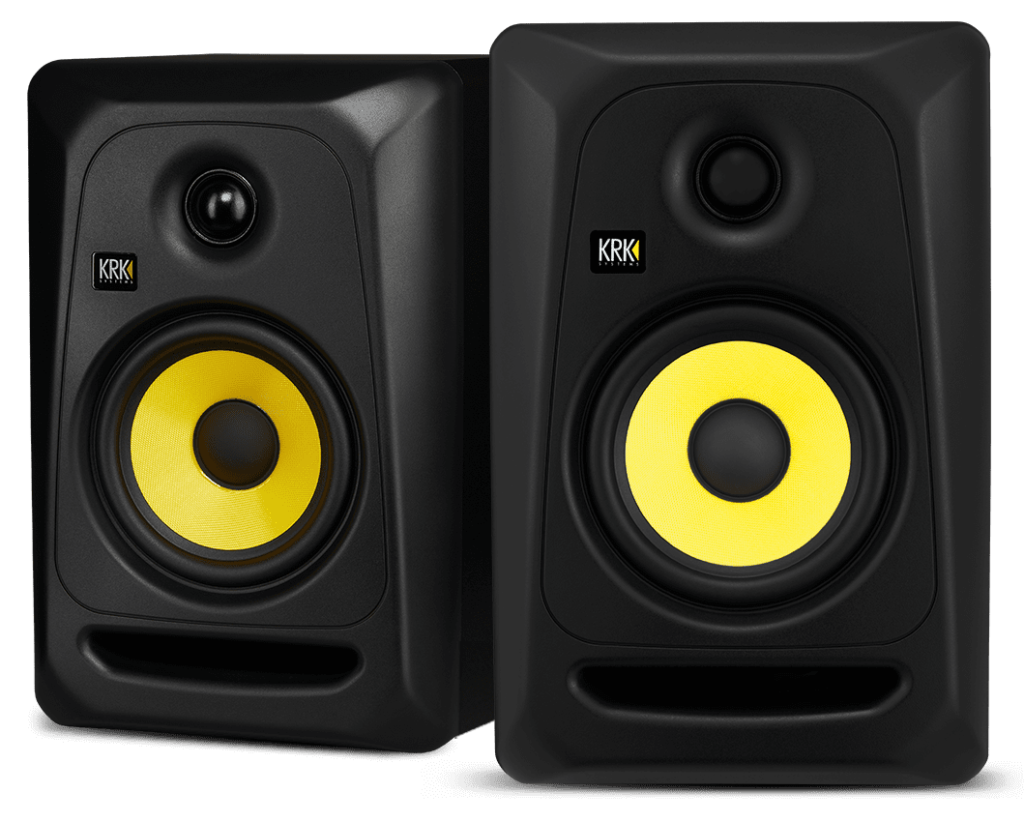
Since 1986 KRK Systems has been producing some of the best studio monitors in the industry, such is the case of the affordable KRK Classic 5. At this price range, it delivers excellent sound, high quality, and it’s designed to meet or exceed your expectations.
The Sound Quality of the KRK Classic 5
When it comes to sound quality, the KRK Classic 5 delivers smooth, pristine, and articulate highs thanks to its 1” soft-dome tweeter and optimized waveguide technology. The midrange is clear, and the bass is tight and accurate thanks to its 5” lightweight, glass-aramid composite woofer.
The frequency range goes from 45Hz to 35kHz. The crossover frequency is 2.6kHz. The monitor is bi-amplified using two Class-AB amplifiers per component for a total of 50W—a 20W amp for the HF driver and a 30W amp for the LF woofer. Peak SPL is set at 106dB.
Build Quality
The Classic 5 from KRK is built using MDF wood for the speaker cabinet, provided a medium density material that helps in reducing unwanted low-frequency harmonics.
Features
- It comes with high and low-frequency controls allowing you to contour your sound to your environment and preference.
- System-optimized auto-limiter prevents unexpected peaks from damaging the speakers while offering consistency and clarity at high volumes (2)
- The Class-AB amplifiers provide low distortion and large headroom.
Pros
- As a budget option, this monitor is excellent.
- Good looking speakers.
- They have HF and LF trim controls.
- Good option for a home studio setup.
Cons
- Some customers have complained that you need to get a ground loop isolators because you can easily hear the 60Hz hum.
- They are sold per unit, for a studio, you need two of them.
- For the same price, you can get a better speaker like the Kali LP-6 or JBL 305P
- Depending on your ears, you can find that the bass could get too overpowering and moody.
I/O Capabilities and Controls
Inputs
- 1 x Unbalanced RCA
- 1 x Balanced 1/4″ TRS Jack
- 1 x XLR connector
Controls
- Volume Control Knob (-30dB to +6dB)
- HF Level control (-2dB, -1dB, 0, +1dB)
- LF Level Control (-2dB, -1dB, 0, +2dB)
Dimensions and Weight
Dimensions
- Cabinet Dimensions 9.06” x 7.28” x 11.10” (230mm x 185mm x 282mm)
Weight
- Net Weight: 14.1 lbs (6.4 kg)
ADAM Audio T5V
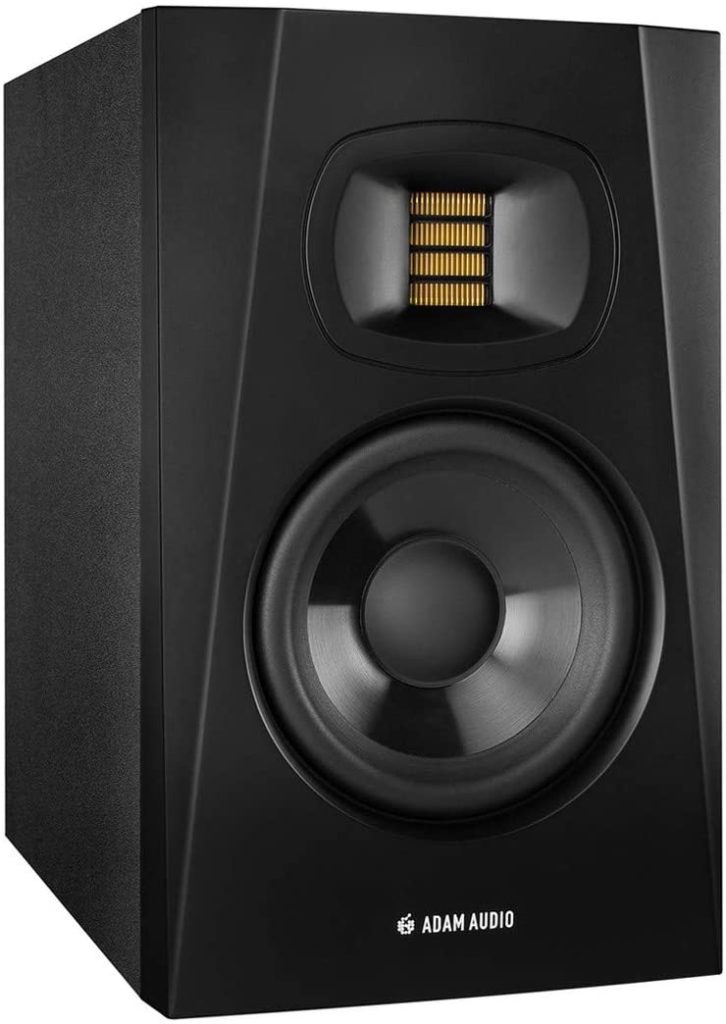
Since it was founded in 1999, Adam Audio has earned a worldwide reputation as one of the leading brands of studio monitors for sound engineers, based on technological innovations that they have established in the field of loudspeaker technology (3).
The T5V is their budget option and is definitively one of the best affordable studio monitors available in the market today, let’s explore why.
The Sound Quality of the Adam Audio T5V
The T5V is a near field monitor that has been optimized for small studios like a home recording studio. Thanks to its 5” polypropylene woofer and rear-firing bass-reflex port, the bass it produces is deep, tight and accurate without sounding muddy; it can go as low as 45Hz.
The high frequencies are reproduced by their proprietary 1.9″ U-ART, which is an Articulate Ribbon Tweeter. It is made from a high-tech polymide film that provides pristine and extended high-frequency response up to 25 kHz (4). This translates in a direct, fast response in the high-range even with complex transients.
The T5V uses a bi-amplified topology using a 20W Class-D amp for the tweeter and a 50W amp for the woofer. The total power of this monitor is 70W RMS. In loudness terms, the maximum SPL is 106dB at 1 meter.
This monitor provides an accurate flat representation of what is present in your mix, giving you the best chance is making the right decisions when mixing or editing your recordings.
Features
- The cabinet is designed to have better acoustics thanks to its optimized geometry.
- The electronic crossover is designed using DSP (Digital Signal Processing)
- The frequency response is linearly flat throughout the whole range.
Pros
- Designed especially for home studios.
- This monitor provides excellent acoustic characteristics.
- Although it is small, it delivers an outstanding cost per performance ratio.
- The tweeter produces exceptional clear highs.
Cons
- No power indication LED to know if the speaker is on or off.
- Some customers have complained that the woofer doesn’t provide a deep bass as they expected. Some people don’t like flat speakers.
- The Adam Audio T5V is sold per unit, and you need to buy two units for a studio.
I/O Capabilities and Controls
Inputs
- 1 x XLR Balanced connector.
- 1 x Unbalanced RCA
Controls
- Switchable Input Sensitivity +4 dBu / -10 dBV
- Volume Knob.
- Switchable High-Shelf control for – 2 dB, 0 dB, +2 dB
- Switchable Low-Shelf control for – 2 dB, 0 dB, +2 dB
Dimensions and Weight
Dimensions
- Height x Width x Depth 11.7″ x 7″ x 11.7″ (298 mm x 179 mm x 297mm)
Weight
- 12.6 lbs (5.7 kg)
Yamaha Hs5 Studio Monitor
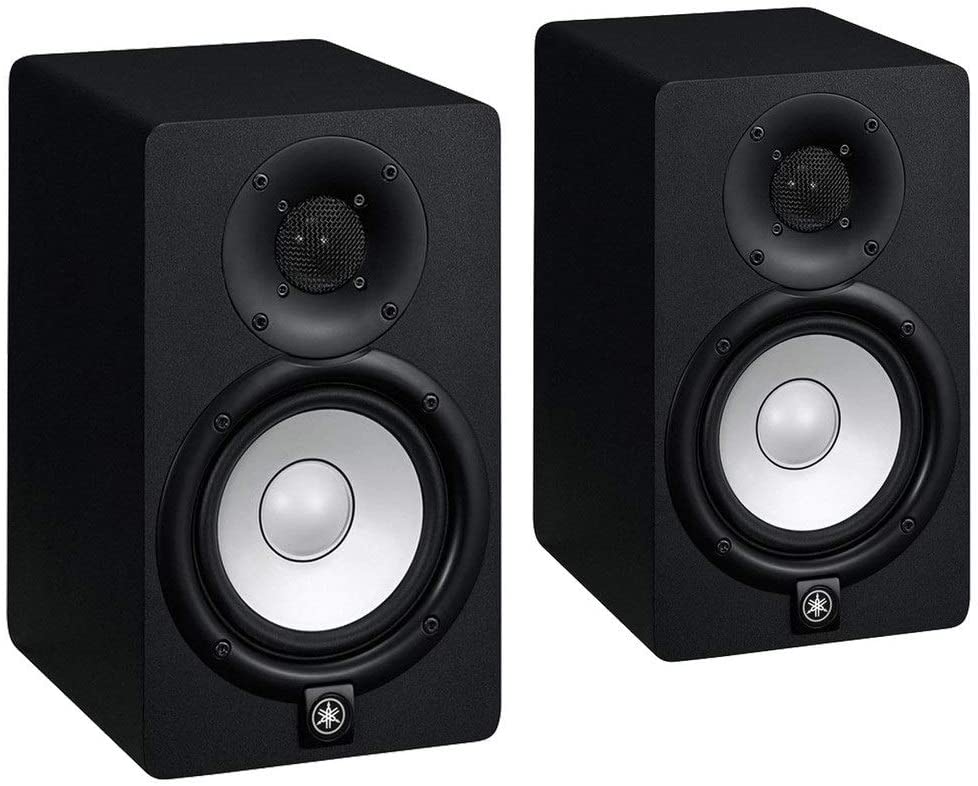
Yamaha first introduced their near field monitors back in the ’70s with the iconic white woofer, and since then, it has become an industry-standard in recording studios around the world. The only reason behind their success is the accuracy they provide.
Unlike other studio monitors that add bass and treble to the sound coming from the mixer, the Hs5 provides you with an accurate, uncolored sound giving you the best shot to EQ your recording session and get the best possible recording.
The Sound Quality of the Yamaha Hs5
To achieve accurate sound, you need carefully designed and constructed components and an acoustically built cabinet. The Hs5 has both, and they use a high performance 5″ woofer and a 1″ dome tweeter.
The sound of this monitor is crystal clear over the whole range of frequencies. It is so good that you won’t need to use headphones for mixing or editing because these speakers “tell the truth” they will let you know how it actually sounds.
They provide enough loudness to fill a medium-sized room thanks to its 70W amplifier. It is bi-amped with a 25W amp for the tweeter and 45W amp for the woofer.
The frequency range goes from 54Hz to 30kHz. The crossover frequency is set at 2kHz.
Build Quality
The Hs5 cabinet is designed and constructed using different techniques that Yamaha has perfected for the past 40 years to eliminate unwanted resonance and increase the accuracy of sound reproduction.
The Yamaha Hs5 is built using a high-density MDF wood to make the cabinet with a damped acoustic response. They only use good quality material to make this and all the monitors they produce.
Features
- High-performance amplifiers with very low distortion.
- They use newly developed transducers in the HS series.
- It has all the controls and connectivity needed in a studio environment.
- They are designed and constructed using all the knowledge learned in the years of experience obtained making monitors.
- Optimum response in any small to medium-sized rooms.
Pros
- This monitor delivers crystal clear sound comparable with professional headphones.
- Acclaimed by many music producers around the world.
- They have a very flat response, perfect for mixing and editing.
Cons
- They are a bit pricy if you are on a tight budget.
- Don’t expect to get a deep, punchy bass with this monitor.
I/O Capabilities and Controls
Inputs
- 1 x XLR balanced connector
- 1 x 1/4” TRS balanced connector
Controls
- Volume control +4dB/center click
- Switchable EQ trim +/- 2dB at HF
- Switchable ROOM CONTROL 0/-2/-4 dB under 500Hz